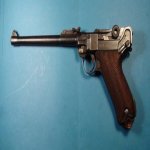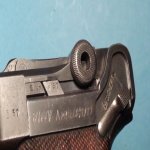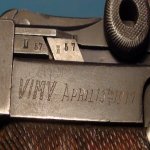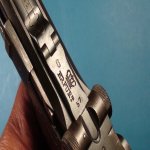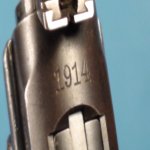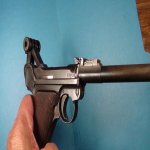You are using an out of date browser. It may not display this or other websites correctly.
You should upgrade or use an alternative browser.
You should upgrade or use an alternative browser.
Vimy Ridge Luger
- Thread starter lugercollector
- Start date
Very nice but this government would be happy to toss that in a smelter.
This government would be happy to dump all handguns in the smelter, whether they have historical value or not.
At least this beauty is not the regular short barreled one, but a long barreled Artillery P08 (Lange Pistole)
- Location
- Algoma, ON
Stunning. I'd love to know about the provenance. Who brought it back, how it was found.
Definitely this....there's a story there somewhere and I'd love to hear it.
Don't know the story......Would also like to know!!
I have a 1938 Luger inscribed from WW2 was a RAF bring back don't know the story would also like to know they all need to be persevered.
Certain things can be assumed.
German artillery was supporting entrenchments on the ridge. When Currie's Canadians were called upon to do the job, they trained and trained for months leading up to the attack using scaled down models of what was known about the German entrenchments.
Part of the Canadian training was to have men hang back from the advancing troops as clean-up crews. These men would zig zag behind the advance, the advance was moving in coordination with a creeping barrage and the barrage came after a near 24 hour artillery pounding. General Currie had learned from errors that were realized on prior attempts to take the ridge. Previously, the advancing troops moved right over German emplacements, the Germans then rising in their trenches, turned to fire into the backs of the advancing British/French. This zig-zag, mop up crew, was designed to prevent anyone from being shot in the back. The men could advance with confidence.
I don't recall reading that the Canadians were ordered not to take prisoners, but from everything I've read, I don't believe an order needed to be issued. There was plenty of animosity.
As the German positions became obliterated, and or, as the creeping barrage and advancing Canadians swept the ridge there was a route. The German Army, or what was left of it, retreated to Vimy and the battle was won. As we're all aware, many war trophies were taken that day and in the days to follow. Entire German artillery pieces made it back to Canada from Vimy as well as untold numbers of Maxim Guns etc. There was a time that just about every Canadian Legion had a piece of militaria taken from Vimy or other major WW! battles on display. Invariably, this Luger was located somewhere along the German artillery position. While they left their guns, I can't imagine they would have dropped a side arm. Could have been liberated from a surrendering officer, more likely to have been taken from a man turned cadaver, care of British shrapnel though.
Some guys are mentioning RAF members bringing back articles. There would have been a lot of trading and bartering on base where war trophies are concerned. Lugers, Picklehaube's, sabers, daggers, all would have been up for grabs...if you had the coin or whisky and a willing trading partner.
German artillery was supporting entrenchments on the ridge. When Currie's Canadians were called upon to do the job, they trained and trained for months leading up to the attack using scaled down models of what was known about the German entrenchments.
Part of the Canadian training was to have men hang back from the advancing troops as clean-up crews. These men would zig zag behind the advance, the advance was moving in coordination with a creeping barrage and the barrage came after a near 24 hour artillery pounding. General Currie had learned from errors that were realized on prior attempts to take the ridge. Previously, the advancing troops moved right over German emplacements, the Germans then rising in their trenches, turned to fire into the backs of the advancing British/French. This zig-zag, mop up crew, was designed to prevent anyone from being shot in the back. The men could advance with confidence.
I don't recall reading that the Canadians were ordered not to take prisoners, but from everything I've read, I don't believe an order needed to be issued. There was plenty of animosity.
As the German positions became obliterated, and or, as the creeping barrage and advancing Canadians swept the ridge there was a route. The German Army, or what was left of it, retreated to Vimy and the battle was won. As we're all aware, many war trophies were taken that day and in the days to follow. Entire German artillery pieces made it back to Canada from Vimy as well as untold numbers of Maxim Guns etc. There was a time that just about every Canadian Legion had a piece of militaria taken from Vimy or other major WW! battles on display. Invariably, this Luger was located somewhere along the German artillery position. While they left their guns, I can't imagine they would have dropped a side arm. Could have been liberated from a surrendering officer, more likely to have been taken from a man turned cadaver, care of British shrapnel though.
Some guys are mentioning RAF members bringing back articles. There would have been a lot of trading and bartering on base where war trophies are concerned. Lugers, Picklehaube's, sabers, daggers, all would have been up for grabs...if you had the coin or whisky and a willing trading partner.
I had a neighbour years ago who had a very nice German dress dagger. I was interested in how he obtained it. I do know he was a Sgt in the RCAF and was in Belgium with 2nd Tactical Air Force (if I remember correctly-). Traded a few bars of soap for the dagger. He also had a couple Iron Crosses - what level I have no idea.















































